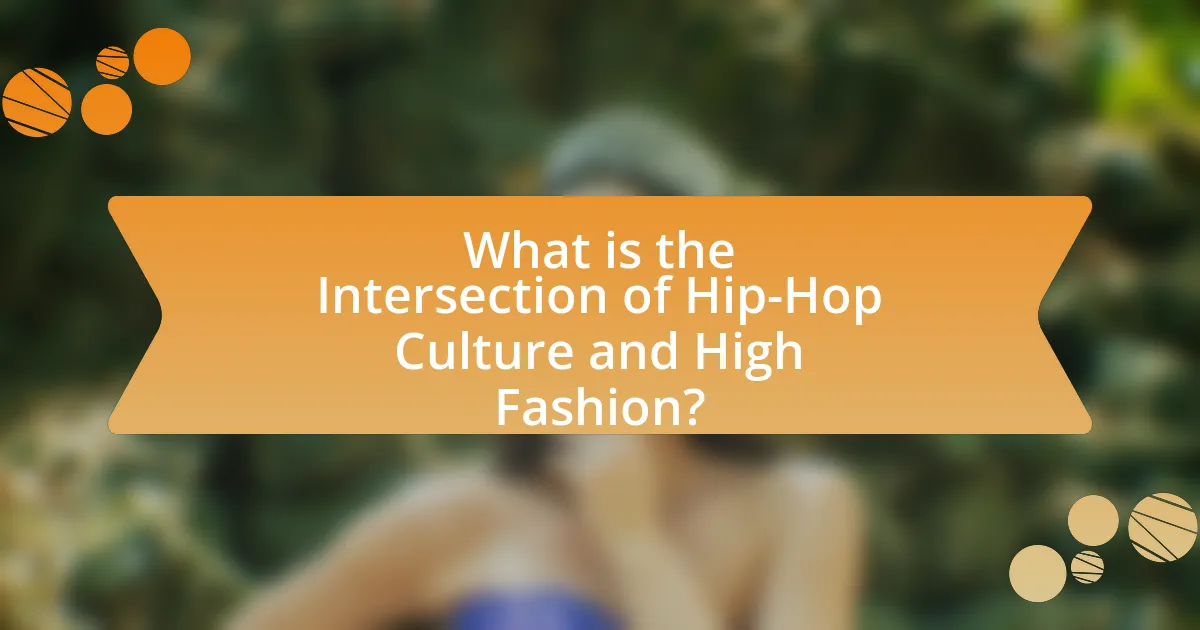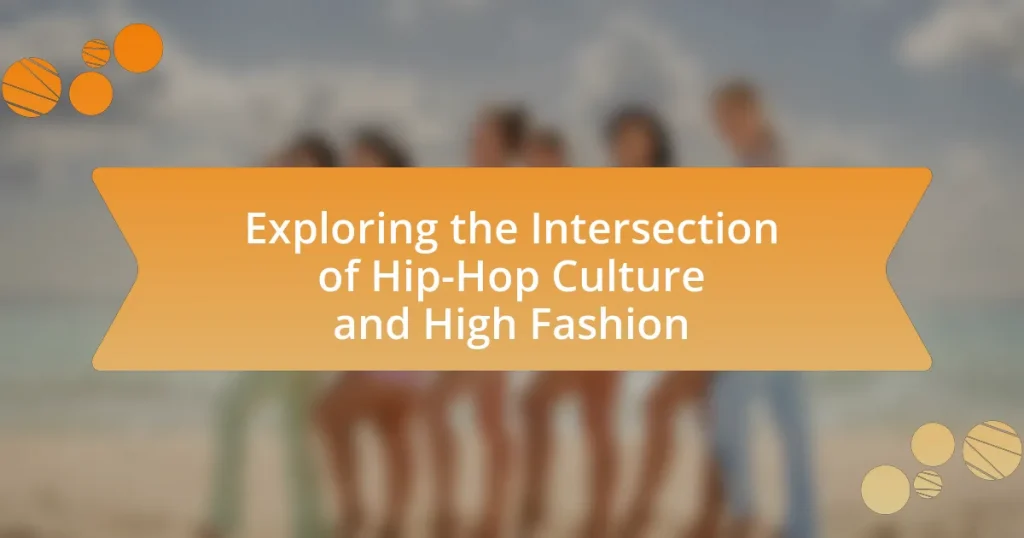The article explores the intersection of hip-hop culture and high fashion, highlighting the mutual influence between streetwear aesthetics and luxury fashion. It traces the origins of this relationship back to the late 20th century, emphasizing key collaborations between hip-hop artists and brands, such as Run-D.M.C. with Adidas and Kanye West with Louis Vuitton. The article discusses how hip-hop has reshaped fashion trends, marketing strategies, and consumer perceptions, while also examining the cultural impacts and challenges to traditional fashion norms. Additionally, it addresses emerging trends, the role of technology and social media, and best practices for aspiring designers looking to navigate this evolving landscape.

What is the Intersection of Hip-Hop Culture and High Fashion?
The intersection of hip-hop culture and high fashion is characterized by a mutual influence where streetwear aesthetics and luxury fashion converge. This relationship began in the late 20th century, with hip-hop artists like Run-D.M.C. collaborating with brands such as Adidas, which popularized the idea of wearing sportswear as high fashion. Today, designers like Virgil Abloh of Off-White and brands like Balenciaga incorporate hip-hop elements into their collections, reflecting the genre’s impact on mainstream fashion. The 2021 Met Gala, featuring artists like Lil Nas X in designer outfits, exemplifies this ongoing trend, showcasing how hip-hop continues to shape high fashion narratives.
How did Hip-Hop Culture influence High Fashion?
Hip-Hop culture significantly influenced high fashion by introducing streetwear aesthetics, which emphasized comfort, individuality, and urban identity. This cultural movement led to collaborations between hip-hop artists and luxury brands, such as the partnership between Kanye West and Adidas for the Yeezy line, which generated over $1 billion in sales. Additionally, hip-hop’s emphasis on self-expression and status reshaped fashion marketing, prompting high-end designers like Gucci and Louis Vuitton to incorporate elements of street style into their collections, thereby bridging the gap between luxury and everyday wear.
What historical events marked the beginning of this intersection?
The intersection of hip-hop culture and high fashion began in the late 1970s and early 1980s, marked by the emergence of hip-hop as a cultural movement and the influence of artists like Run-D.M.C. Their collaboration with Adidas in 1986, particularly the endorsement of the brand’s Superstar sneakers, solidified this connection. This partnership not only popularized streetwear but also established hip-hop as a significant force in fashion, leading to further collaborations between artists and luxury brands, such as the later partnerships of Kanye West with Louis Vuitton and Pharrell Williams with various high-end labels.
How have key figures in Hip-Hop shaped fashion trends?
Key figures in Hip-Hop have significantly shaped fashion trends by popularizing streetwear and luxury brands, creating a unique blend of styles that influence global fashion. Artists like Run-D.M.C. brought Adidas tracksuits and sneakers into mainstream culture, while Kanye West’s collaboration with Louis Vuitton and later Yeezy line redefined luxury streetwear. Additionally, figures such as Pharrell Williams and A$AP Rocky have pushed boundaries by incorporating high fashion into everyday wear, leading to a rise in designer collaborations and the acceptance of bold, eclectic styles. This influence is evidenced by the increasing presence of Hip-Hop artists at major fashion events and their partnerships with high-end brands, demonstrating the genre’s pivotal role in shaping contemporary fashion.
Why is the relationship between Hip-Hop and High Fashion significant?
The relationship between Hip-Hop and High Fashion is significant because it represents a cultural exchange that influences trends, identity, and economic power. Hip-Hop artists have historically used fashion as a means of self-expression and social commentary, which has led to collaborations with luxury brands like Gucci and Balenciaga, thereby elevating streetwear to high fashion status. This intersection has reshaped the fashion industry, as evidenced by the rise of brands like Off-White, founded by Virgil Abloh, who was deeply rooted in Hip-Hop culture. The financial impact is substantial; for instance, the global streetwear market was valued at approximately $185 billion in 2021, showcasing the economic clout of this relationship.
What cultural impacts arise from this relationship?
The relationship between hip-hop culture and high fashion has led to significant cultural impacts, including the democratization of fashion and the elevation of streetwear as a legitimate fashion category. This intersection has allowed hip-hop artists to influence mainstream fashion trends, resulting in a shift where luxury brands increasingly collaborate with hip-hop figures, thereby blurring the lines between high fashion and everyday wear. For instance, brands like Gucci and Balenciaga have embraced streetwear aesthetics, reflecting the cultural significance of hip-hop in shaping contemporary fashion narratives. This collaboration not only enhances the visibility of hip-hop culture but also fosters a sense of identity and community among fans, as they engage with fashion that resonates with their cultural experiences.
How does this intersection challenge traditional fashion norms?
The intersection of hip-hop culture and high fashion challenges traditional fashion norms by promoting inclusivity and redefining luxury. This fusion disrupts the conventional elitism associated with high fashion, as hip-hop artists often prioritize personal expression and cultural identity over established fashion standards. For instance, collaborations between streetwear brands and luxury houses, such as the partnership between Off-White and Louis Vuitton, illustrate how this intersection democratizes fashion, making it accessible to a broader audience. Additionally, hip-hop’s emphasis on individuality encourages diverse styles that contrast with the uniformity typically seen in traditional fashion, thereby reshaping consumer expectations and industry practices.

What are the Key Elements of Hip-Hop Fashion?
The key elements of hip-hop fashion include oversized clothing, bold graphics, athletic wear, and distinctive accessories. Oversized clothing, such as baggy jeans and large t-shirts, became popular in the 1980s and 1990s, reflecting the culture’s roots in street style and comfort. Bold graphics often feature logos, slogans, and vibrant colors, showcasing individuality and brand loyalty. Athletic wear, including tracksuits and sneakers, emphasizes functionality and has been influenced by hip-hop artists’ connections to sports. Distinctive accessories, such as snapback hats, gold chains, and statement jewelry, serve as symbols of status and personal expression within the hip-hop community. These elements collectively represent the cultural identity and evolution of hip-hop fashion.
How do clothing styles reflect Hip-Hop culture?
Clothing styles reflect Hip-Hop culture by embodying its values of self-expression, individuality, and social commentary. The oversized silhouettes, bold graphics, and vibrant colors commonly seen in Hip-Hop fashion serve as a visual representation of the genre’s roots in urban environments and its connection to street culture. For instance, brands like FUBU and Rocawear emerged in the 1990s, emphasizing pride in Black identity and community, which are central themes in Hip-Hop. Additionally, the adoption of sportswear and luxury brands by Hip-Hop artists illustrates a blend of accessibility and aspiration, showcasing how clothing can signify status and cultural relevance. This intersection of fashion and music has led to collaborations between Hip-Hop artists and high-end designers, further solidifying the genre’s influence on contemporary fashion trends.
What are the most iconic fashion items associated with Hip-Hop?
The most iconic fashion items associated with Hip-Hop include oversized clothing, sneakers, baseball caps, gold chains, and tracksuits. Oversized clothing became popular in the 1980s and 1990s, reflecting the style of influential artists like Run-D.M.C. Sneakers, particularly brands like Adidas and Nike, have been integral to Hip-Hop culture, with the Adidas Superstar gaining fame through the song “My Adidas.” Baseball caps, often worn backward, symbolize urban street style, while gold chains represent wealth and status, frequently showcased by artists such as Notorious B.I.G. Tracksuits, especially those by brands like FUBU and Sean John, have also been staples in Hip-Hop fashion, emphasizing comfort and style. These items collectively illustrate the cultural significance and evolution of Hip-Hop fashion over the decades.
How do accessories play a role in Hip-Hop fashion statements?
Accessories are crucial in Hip-Hop fashion statements as they serve to express individuality and status. Items such as oversized sunglasses, chunky jewelry, and branded caps not only enhance an outfit but also signify cultural identity and personal style. For instance, the use of gold chains and diamond-encrusted pieces has historical roots in Hip-Hop, symbolizing wealth and success, which is often celebrated in the genre’s lyrics and visuals. Furthermore, accessories like sneakers and designer bags are frequently highlighted in music videos and social media, reinforcing their importance in establishing a fashion narrative within the Hip-Hop community.
What role do brands play in the Hip-Hop and High Fashion intersection?
Brands serve as crucial facilitators in the intersection of Hip-Hop and High Fashion by shaping cultural narratives and influencing consumer behavior. They leverage the authenticity and creativity inherent in Hip-Hop culture to create exclusive collaborations, which enhance brand visibility and appeal to a diverse audience. For instance, brands like Gucci and Off-White have successfully integrated Hip-Hop aesthetics into their collections, often featuring prominent artists in their campaigns, thereby reinforcing their relevance in contemporary fashion. This symbiotic relationship not only elevates the status of Hip-Hop artists but also allows brands to tap into the cultural capital associated with the genre, driving sales and brand loyalty.
Which brands have successfully collaborated with Hip-Hop artists?
Nike, Adidas, and Puma have successfully collaborated with Hip-Hop artists. Nike partnered with artists like Travis Scott and Drake, creating limited-edition sneakers that generated significant sales and cultural impact. Adidas collaborated with Kanye West on the Yeezy line, which has become one of the most sought-after sneaker collections, achieving billions in revenue. Puma has worked with artists such as Rihanna and Jay-Z, enhancing its brand visibility and appeal within the Hip-Hop community. These collaborations not only elevated the brands’ status but also reinforced the strong connection between Hip-Hop culture and high fashion.
How do these collaborations influence consumer perceptions?
Collaborations between hip-hop culture and high fashion significantly influence consumer perceptions by enhancing brand desirability and cultural relevance. These partnerships often leverage the authenticity and creativity associated with hip-hop, attracting a younger, trend-conscious demographic. For instance, when luxury brands collaborate with hip-hop artists, they tap into the artists’ influence and social media reach, which can lead to increased brand visibility and consumer engagement. A study by the Harvard Business Review found that collaborations can elevate brand equity by 20% when they resonate with the target audience, demonstrating the tangible impact of such partnerships on consumer attitudes and purchasing behavior.

How is the Future of Hip-Hop and High Fashion Evolving?
The future of hip-hop and high fashion is evolving through increased collaboration and mutual influence, as seen in partnerships between hip-hop artists and luxury brands. For instance, artists like Kanye West and Pharrell Williams have successfully merged streetwear aesthetics with high fashion, leading to significant shifts in consumer behavior and brand strategies. This evolution is supported by the growing acceptance of hip-hop culture in mainstream fashion, evidenced by high-profile runway shows featuring hip-hop-inspired designs and the inclusion of hip-hop artists in major fashion campaigns. The rise of social media platforms further amplifies this trend, allowing for real-time engagement and the rapid dissemination of fashion trends rooted in hip-hop culture.
What trends are emerging in the Hip-Hop fashion scene?
Emerging trends in the Hip-Hop fashion scene include oversized silhouettes, vibrant colors, and a blend of streetwear with luxury brands. Oversized clothing, such as baggy pants and large graphic tees, reflects a nostalgic nod to 90s hip-hop aesthetics while promoting comfort. Vibrant colors and bold patterns are increasingly popular, showcasing individuality and self-expression. Additionally, collaborations between streetwear labels and high-fashion brands, like the partnership between Off-White and Nike, highlight the merging of these two worlds, indicating a shift towards more inclusive and diverse fashion narratives. This trend is supported by the growing influence of hip-hop artists as fashion icons, further solidifying the genre’s impact on contemporary style.
How is technology impacting the way Hip-Hop fashion is created and consumed?
Technology is significantly transforming the creation and consumption of Hip-Hop fashion by enabling rapid design processes and enhancing accessibility. Digital tools such as 3D modeling software allow designers to create innovative styles quickly, while social media platforms facilitate direct engagement between brands and consumers, promoting trends in real-time. For instance, the rise of platforms like Instagram and TikTok has led to the phenomenon of “micro-trends,” where styles can gain popularity overnight, driven by influencers and viral content. Additionally, e-commerce advancements have made it easier for consumers to access Hip-Hop fashion globally, allowing for a diverse range of styles to be shared and adopted across different cultures. This technological integration not only accelerates the fashion cycle but also democratizes fashion, giving rise to independent designers who can reach audiences without traditional retail barriers.
What role does social media play in shaping future trends?
Social media significantly influences the shaping of future trends by providing a platform for rapid dissemination and engagement with new ideas and styles. It allows creators, influencers, and brands to showcase emerging trends in real-time, facilitating immediate feedback and adaptation. For instance, platforms like Instagram and TikTok have been pivotal in popularizing streetwear and high fashion collaborations, as seen with brands like Off-White and their integration into mainstream fashion, which gained traction through viral posts and influencer endorsements. This dynamic interaction between users and content accelerates trend adoption and evolution, making social media a crucial driver in the fashion industry.
What can we learn from the intersection of Hip-Hop Culture and High Fashion?
The intersection of Hip-Hop culture and high fashion teaches us about the influence of cultural identity on style and consumer behavior. This relationship highlights how Hip-Hop artists, such as Kanye West and Pharrell Williams, have transformed streetwear into a luxury market, demonstrating that authenticity and self-expression can drive fashion trends. For instance, the collaboration between Off-White and Nike, led by designer Virgil Abloh, showcases how Hip-Hop aesthetics can elevate brand value and appeal to a broader audience. This fusion also emphasizes the importance of inclusivity and diversity in fashion, as Hip-Hop culture often challenges traditional fashion norms and promotes a more accessible approach to style.
How can aspiring designers leverage this intersection for success?
Aspiring designers can leverage the intersection of hip-hop culture and high fashion by incorporating streetwear aesthetics and cultural narratives into their designs. This approach allows them to connect with a diverse audience that values authenticity and self-expression, which are central tenets of both hip-hop and high fashion. For instance, brands like Off-White and Fear of God have successfully blended these elements, achieving significant commercial success and cultural relevance. By studying these successful models, aspiring designers can understand the importance of storytelling and cultural representation in their work, ultimately enhancing their marketability and brand identity.
What best practices should be followed when merging these two worlds?
To effectively merge hip-hop culture and high fashion, brands should prioritize authenticity and collaboration. Authenticity ensures that the fashion reflects the true essence of hip-hop, which is rooted in self-expression and cultural identity. Collaborating with influential hip-hop artists and designers can create collections that resonate with both communities, as seen in successful partnerships like Kanye West’s Yeezy line with Adidas, which generated over $1 billion in revenue. Additionally, brands should engage with the hip-hop community through events and sponsorships, fostering genuine connections that enhance brand credibility and appeal.



